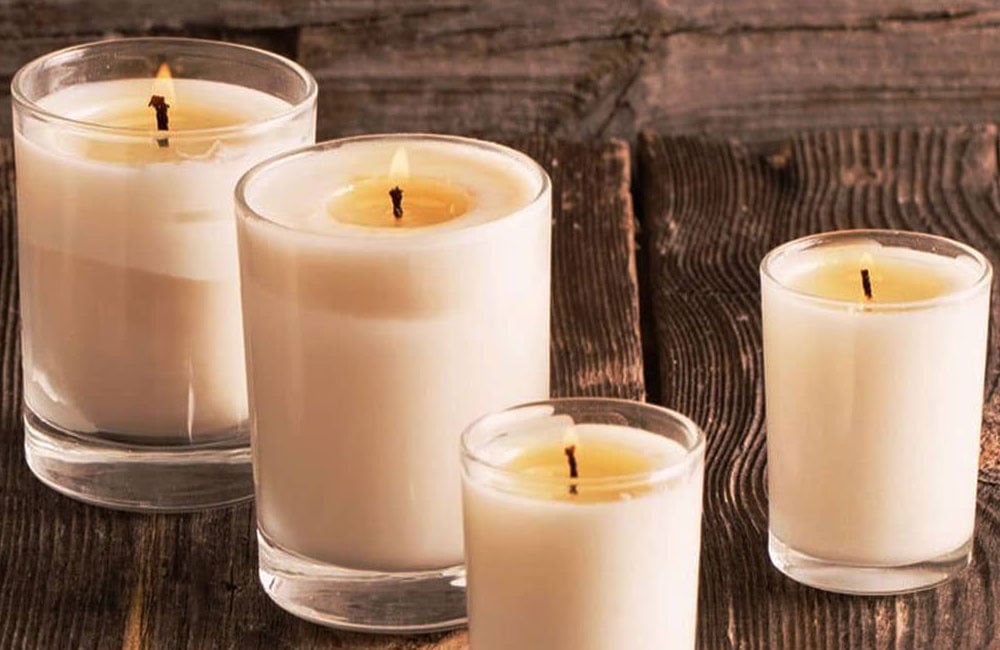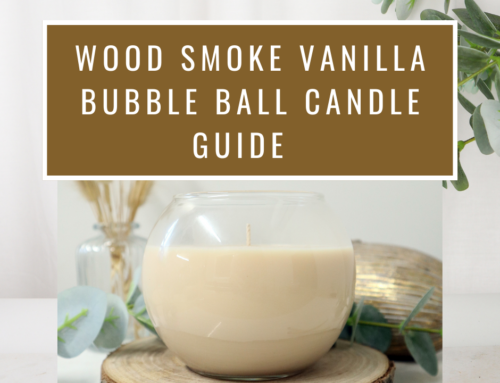Discover Candle Making FAQs And Answers
Appearance Related Problems
Why does my candle sink in the middle when cooling?
This is known as a sink hole and is quite normal so don’t be overly concerned – this happens to everybody, even the professionals. This reaction is caused by the wax shrinking as it cools and there are a few options to try to avoid or rectify this. You can pour the wax at a lower temperature allowing for a smaller shrinkage to happen or alternatively, heating the container you are pouring your wax in to can help reduce the extent of this reaction.
However, the most effective way of dealing with this problem is to not pour all of your wax in on the first pour. Leave a small amount to one side and as the candle starts cooling (but is still quite warm), apply another thin layer on top until the hole is filled, leaving you with a smooth surface. Be careful not to overheat the wax used for the second pour and do not pour the wax higher than the first pour or it creates an unsightly rim around the top of the candle. A third pour may also be necessary. We always recommend leaving some of the same wax from the same batch for this as creating the exact same colour on another batch can be difficult to achieve.
Why is my second pour a different colour to my first?
If the second pour is at a cooler temperature to what the first wax was poured at, this will affect the colour as the wax cools. You should also do your re-pour whilst the candle is still warm and hasn’t fully set yet. For the best results, your re-pour should only be a couple of degrees lower than the molten wax was on the first pour.
Why are there small air bubbles in my candle?
There are several things that can cause bubbles within your candle but don’t worry, this is a very common problem and can be easily resolved. The most common cause is rushing! For example, your candle wax cooling too quickly or the wax being poured into your container was being poured in too fast. When stirring your dye and fragrance into your molten wax you need to be careful not to do this too vigorously as you can trap air bubbles into the mixture which can then be seen in the cooled candle. Ways you can avoid this are pouring the wax into a warmed container at a slow pace, some people even recommend tapping the container gently once poured to help release the air bubbles. Also using a hair dryer on a semi-cooled candle can help encourage the bubbles to rise out of the candle.
My candle has cracks in it, why is this?
This is the most common error made when making candles and the cause is the easiest to correct. This occurs as a consequence of the candle being cooled too fast. You can prevent this by warming the candle container prior to the pour or cooling the candle with the container being submerged in warm water. Alternatively, this is a great effect to play with if you are looking to experiment with different finishes on your pillar candles especially. Please see our techniques section for some fun ideas with cooling techniques.
What has caused the white lines/frosty patches in my candle?
Again, this is another issue caused by cool temperatures either of the wax when it is being poured or the cool temperature of your glass and is made worse if there is a combination of the two at play. The easiest solution to this is to ensure that you are using a thermometer to measure the temperatures of your wax at all stages and are pouring this into your container around 65°C. If the candles are being made in a particularly cold environment it will also be worthwhile heating your container prior to the pouring.
Why is my candle pulling away from my container causing a large air bubble?
There are two main causes for this, the first being unclean surfaces on the inside of your container so please ensure that this is clean and clear of any particles. Secondly it can be caused by the wax cooling too quickly and therefore shrinking, you can avoid this by either pouring your wax at a cooler temperature (thus shrinking less) or heating your container prior to pouring. If after this, you are still having ‘wet spots’ you can use a heat gun (hair dryer) to heat the container, re-melting the wax and encouraging the air to disperse and the wax to sit flush against the container.
Why is the top of my candle at a slant (ie not completely horizontal)?
Simple reason which is that when pouring the wax, the mold has not been placed and allowed to cool on a perfectly level surface.
Wick Related Problems
How do I keep the wick secure and in an up-right position?
Ahead of any pouring you need to ensure the wick is secure.
If you are using an unstiffened or non-pre-waxed wick or wick sustainer (also known as a tab) dip the wick in the melted wax (while the wax is still in the pan) and then place this in the centre of the container or where desired allowing the wax to cool and secure the bottom end in position (using a metal tab – sustainers already come with these fitted). Before putting the wick into position, make sure it is straight/taut. If you are using a pre-waxed wick sustainer, you simply need to dip the metal tab at the bottom of the wick into the wax and then place into your container. Allow to dry.
If you are using a specialist candle mold, in most cases you will find a hole at the bottom of the mold through which the non-pre-waxed wick is secured. The wick is passed through the hole and knotted, pulled taut and secured at the top of the mold (sometimes a small amount of blu tack® (or equivalent) is used at the bottom of the candle mold to ensure no leakage). The mold may have a ‘lip’ at the base so that it does not tilt when the wick is secured. No pre-waxing is needed in this case.
If you plan on tilting the container to create different levels and effects, it may be worth securing the metal tab with the use of a small amount of blu tack® (or equivalent). Alternatively, you can {carefully} use a hot glue gun when working with a glass container.
You then need to secure the tip of the wick over the top of the container and you can do this with the use of many house hold objects – clothes peg, hair comb, two pencils and chop sticks – as these will hold the wick in place and then rest across the top of the container. Explore and find out what works best for you.
Why is my flame burning out/struggling to stay lit/drowning?
The main cause for this is you are using a wick that is too small in relation to the size of candle you have. To avoid this, you should check you are using the right sized wick for your candle. We do have a guide for this; please refer to this to find the recommended wick size in relation to the candle diameter. The tab to find this advice can be found in each of the wick listings. Another cause could be that the volume of candle dye is too high and therefore clogging the wick, so double check you are not using too much dye in relation to the amount of wax you are mixing it with. You may need to ensure that the wick you are using is primed (pre-coated in wax).
What is causing my flame to flicker a lot?
This is often because the wick is too large, so try using a smaller wick to resolve this issue. Alternatively, there could also be water within your hardened candle, so ensure when melting the wax, no water is mixed with the wax. We do have a guide for what wick to use in relation to your candle size.
Why is my candle smoking as it’s being burnt?
There are several things that can cause this, the most common being the wrong size of wick being used or the length of the wick as it rises out of the wax at the top of the candle is too long. If the candle wick is the wrong size, try using a thinner wick and/or cut the wick at the top of the candle down to a half cm tall. Another cause could be that the level of fragrance oil used is too great a percentage in relation to the amount of wax. We do have a guide for how much fragrance oil to use.
Why do I have such a small melt pool and the candle is tunnelling?
This will be because you are using a wick that is too small in relation to the candle, which is limiting the amount of wax that you will burn through. This will also cause high walls of wax around the flame as it burns down which, depending on the height of the candle, may cause the flame to extinguish.
Fragrance Related Questions
Why is my fragrance not being released when burning the candle?
There are a few reasons this could happen. You need to be sure that you are using the right amount of fragrance (please refer to fragrances for guidelines on how much to use), as not enough fragrance can cause this. Likewise, using a poor-quality fragrance with a low concentration will affect your results. The other thing to bear in mind is that all fragrances have a flash point (the temperature at which the fragrance is released/evaporates from the wax) and therefore the oil should be added to the wax while it is in the pan prior to pouring when the wax is at a temperature lower than the fragrances’ flash point. If you add the fragrance when the wax is at too high a temperature, the scent will completely evaporate before the wax is poured into its container/mould. All our fragrances have their flash points listed under their data sheets on each fragrance product listing.
Why is the fragrance oil settling to the bottom of the candle?
This normally occurs when you are using too much fragrance or the wax you are using is not porous enough to hold the fragrance. Make sure you are using the correct amount of fragrance in relation to the wax.
Why do I have oil patches on the surface of my candle?
This is again caused by the presence of too much fragrance oil in the wax.
Why is my candle burning too quickly?
This is primarily caused by a wick that is too big for the size of candle made and thus reducing the burn time of the candle. If your wax is too soft you can maximise your burn time by adding a hardening agent. If there are air bubbles/pockets in the cooled candle this can also increase the burn time.
Candle Dye Related Questions
Why is my candle darker in some places?
This is generally because the candle dye has not been mixed in with the wax successfully. Take more time on the next occasion when making the candle to stir in thoroughly the candle dye. Take a small torch and shine it into the wax as it is being mixed with the dye. Any streaks seen indicates that it is not mixed thoroughly – keep stirring until all streaks have disappeared.
Why does my candle have dye spots on the surface?
This is caused by the dye not fully dissolving into the wax prior to pouring, so to avoid this stir the dye chips thoroughly to ensure they are fully dissolved.
Other
I am having problems removing the candle from the mold.
Should this happen, firstly just apply some slight pressure on the sides of the mold, squeezing very gently. If that doesn’t help, you can use a hair dryer to gently and in an even way warm the outside of the mold. Alternatively purchase a mold release spray to use prior to adding the wax. This is particularly advised if using metal molds. Another alternative is to place the candle in the refrigerator for about 10 minutes (do not put in freezer) – this causes the candle to contract very slightly so that it becomes easier to remove from the mold. Careful not to use too much force if banging the mold on a surface as the wax can crack or chip off. Some professionals will advise ‘seasoning’ a mold by creating a candle (without the wick), removing it from the mold, reheating the same wax, filling the mold again and doing this about five times.
The wax is spitting at me as it heats up!
The most likely cause for this, is the existence of water or some other fluid in the container prior to the wax being added. Ensure all containers are cleaned with a dry rag or better still, paper towels.
The wax is starting to smoke in the pan.
Turn off the heat immediately. Wax has a flash point of around 121°C (250°F) when it can and most likely will catch fire in the same way as most cooking oils will. Always use a wax thermometer and follow guidelines in relation to the melting and pouring temperatures. Never walk away from the wax as it is heating up. A good indicator that the wax is getting near the flash point, is when it becomes completely translucent and starts to ‘wriggle’ like snakes.
Follow us on our social media channels:










Leave A Comment